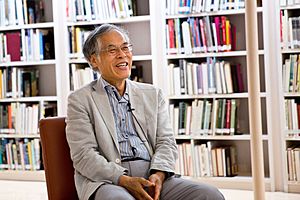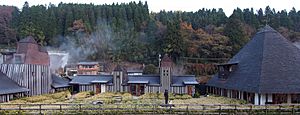Terunobu Fujimori
Quick facts for kids
Terunobu Fujimori
|
|
|---|---|

Fujimori in 2014
|
|
| Born | November 21, 1946 (age 78) Miyakawa-mura, Suwa, Nagano
|
| Alma mater | Tōhoku University University of Tokyo |
| Occupation | Architect |
| Awards | Japan Grand Art Prix, Architectural Institute of Japan Prix for the Student Dormitory of Kumamoto Agricultural College |
| Practice | Terunobu Fujimori |
| Buildings | Takasugi-an Tea House, Lamune Onsen |
Terunobu Fujimori (藤森 照信, Fujimori Terunobu, November 21, 1946) is a Japanese architect and someone who studies the history of buildings.
He spent many years studying cities and old Western buildings before he started designing buildings himself in his forties. His designs are often seen as unique and unusual. He is known for using natural materials in his projects.
Even though he is famous in Japan for sharing his ideas about culture, people in other parts of the world didn't know much about him until he showed his work at the Venice Biennale in 2006. This is a very important international art and architecture show.
Contents
Terunobu Fujimori's Career
Fujimori was born in Miyakawa-mura, which is now part of Chino City in Nagano Prefecture, Japan. He studied at Tōhoku University and then went to graduate school at the University of Tokyo. Today, he is a professor at the University of Tokyo's Institute of Industrial Science.
Becoming an Architectural Detective
In the 1970s, while he was writing his university paper, Fujimori started a group called the Architecture Detectives. He and his friends explored cities to find and take pictures of old Western-style buildings. After 12 years of this work, they published a book called Adventures of an Architectural Detective: Tokyo in 1986.
In the same year, 1986, Fujimori also helped create the Roadway Observation Society. This group looks for unusual but natural patterns in cities. For example, they might notice the shape a tree leaves on a concrete wall or a trash can bent into a seat. Their studies are like looking at everyday things in a new, artistic way.
Starting His Own Architecture Work
Fujimori began designing buildings in 1991. His first project was the Jinchōkan Moriya Historical Museum in Chino, Nagano. When he designs, he gets ideas from famous architects like Le Corbusier and from important Japanese places like the Ise Grand Shrine. He also gets ideas from ancient stone circles like the Callanish Stones.
His buildings are known for being unusual and often funny. He likes to try new things with natural materials and use old building methods in fresh ways. Some people thought the Jinchōkan Moriya Historical Museum just covered a concrete building with natural materials. However, another architect, Kengo Kuma, praised it for making people feel a warm sense of familiarity, even if they had never seen it before.
Sharing His Work with the World
Fujimori is well-known in Japan as an author, a cultural expert, and a TV host. But he was not very famous outside Japan until the 2006 Venice Biennale. At this event, his display in the Japanese section showed houses with plants like leeks and dandelions growing out of them.
Since the Biennale's theme was "the city," Fujimori also included a hut made of woven rice twine. Inside, there was a slide show of the work done by the Roadway Observation Society (ROJO). In 2010, he designed the Beetle's House for an exhibition at the V&A called "1:1 Architects Build Small Spaces."
Fujimori's work with the Roadway Observation Society has inspired younger architects, like Yoshiharu Tsukamoto and Momoyo Kajima from Atelier Bow-Wow. Like Fujimori, they also explored cities to find unusual buildings and shared their discoveries in a book called Made in Tokyo.
In 2018, Fujimori helped as an advisor for an exhibition called "Japan in Architecture: Genealogies of Its Transformations." This show was put together by Fumio Nanjo, the director of the Mori Art Museum.
Takasugi-an Tea House (2003–2004)
The Takasugi-an Tea House is located in Chino, Nagano Prefecture. This special tea house is built high up, about six meters (nearly 20 feet) above the ground. It sits on top of two large trees. Its name means "too high tea house."
Instead of entering in the usual low way, visitors climb a ladder to get inside. Fujimori took traditional tea house ideas and gave them a modern twist. For example, a traditional tea house usually has a picture scroll that hints at the season. But in Takasugi-an, there's a big window that perfectly frames the view of the town where Fujimori grew up. The two chestnut trees that support the tea house were brought from a nearby mountain.
Lamune Onsen (2004–2005)
Lamune Onsen is a hot spring bathhouse in Takeda, Ōita Prefecture. "Lamune" is the name of a popular fizzy drink. This name was chosen because the hot spring water here is bubbly, like the drink. The onsen is owned by a nearby traditional Japanese inn and is used by both guests and the public.
The outside of the building has vertical stripes of charred cedar wood and white plaster. It has many tall towers that let out steam. The roofs of these towers are made of hand-rolled copper sheets. At the very top of each tower, a live pine tree is planted. Inside, the waiting room has furniture made from burnt cedar. In the men's section, one wall is decorated with shiny mother-of-pearl shells.
Nemunoki Museum of Art (2004–2006)
The Nemunoki Museum of Art is in Kakegawa, Shizuoka Prefecture. It was designed to display art made by children with physical disabilities. These children are part of an institute started by the Japanese singer and actress Mariko Miyagi in 1967.
The museum sticks out from a hillside, and Fujimori has compared its design to a "hairy mammoth". The roof, made of hand-rolled copper, connects to the hill with a line of living grass along its top. The path through the museum is carefully planned. Visitors go from the reception area into a beautiful garden, then re-enter the museum through a small door at the back. This journey is meant to give people a moment of peace and thought before they look at the artworks. The inside is simple and white, with a screen above the main gallery that looks like a mammoth's spine.
Awards and Recognition
- Mainichi Publication Culture Award (for Meiji Plans for Tōkyō)
- Suntory Prize for Social Science and Humanities (for Adventures of an Architectural Detective: Tokyo)
- Japan Grand Art Prix for the Nira (Leek) house
- Architectural Institute of Japan Prix for the Student Dormitory of Kumamoto Agricultural College (2001)
Selected Projects
- Jinchōkan Moriya Historical Museum (1991), Chino, Nagano
- Dandelion House (1995), Kokubunji, Tokyo
- Nira House (Leek House) (1997), Machida, Tokyo
- Fuku Akino Art Museum (1998), Hamamatsu City, Shizuoka Prefecture
- Takasugi-an Tea House, (2004), Chino, Nagano
- Chocolate House, (2009), Kokubunji, Tokyo
- Roof House (2009), Shiga Prefecture



